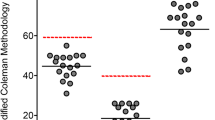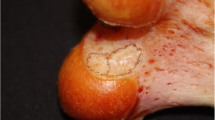Abstract
Purpose
The purpose of this study was to assess the variability of the microfracture technique when performed by experienced knee arthroscopy surgeons.
Method
Four surgeons were each asked to perform microfracture on six preformed cartilage defects in fresh human cadaveric knees. Surgeons were instructed on penetration depth, inter-hole distance, and to place the holes perpendicular to the subchondral surface. Micro-computed tomography was used to calculate depth error, inter-hole distance error, and deviation of penetration angles from the perpendicular.
Results
All surgeons misjudged depth and inter-hole distance, tending to make microfracture holes too deep (depth error 1.1 mm ± 1.9) and too close together (inter-hole distance error: −0.8 mm ± 0.4). Fifty-one per cent of holes were angled more than 10° from the perpendicular (range 2.6°–19.8°). Both depth and distance errors were significantly lower in the trochlear groove than on the femoral condyle (p < 0.05). Surface shearing was associated with both penetration depth >4 mm and angles >20°. Inter-hole infraction occurred in holes closer than 2.5 mm to each other.
Conclusion
Even experienced knee arthroscopy surgeons demonstrate inconsistency in surgical technique when performing microfracture. While further research will be required to demonstrate that these variations in surgical technique are associated with poorer clinical outcomes after microfracture, surgeons should attempt to minimizing such variations in order to prevent surface shearing and inter-hole infraction.




Similar content being viewed by others
References
Basad E, Ishaque B, Bachmann G, Sturz H, Steinmeyer J (2010) Matrix-induced autologous chondrocyte implantation versus microfracture in the treatment of cartilage defects of the knee: a 2-year randomised study. Knee Surg Sports Traumatol Arthrosc 18:519–527
Chen H, Hoemann CD, Sun J, Chevrier A, McKee MD, Shive MS, Hurtig M, Buschmann MD (2011) Depth of subchondral perforation influences the outcome of bone marrow stimulation cartilage repair. J Orthop Res 29:1178–1184
Fazalare JA, Griesser MJ, Siston RA, Flanigan DC (2010) The use of continuous passive motion following knee cartilage defect surgery: a systematic review. Orthopedics 33:878
Harris JD, Brophy RH, Siston RA, Flanigan DC (2010) Treatment of chondral defects in the athlete’s knee. Arthroscopy 26:841–852
Kim I, Paik KS, Lee SP (2007) Quantitative evaluation of the accuracy of micro-computed tomography in tooth measurement. Clin Anat 20:27–34
Knapik DM, Harris JD, Pangrazzi G, Griesser MJ, Siston RA, Agarwal S, Flanigan DC (2013) The basic science of continuous passive motion in promoting knee health: a systematic review of studies in a rabbit model. Arthroscopy 29:1722–1731
Knutsen G, Drogset JO, Engebretsen L, Grontvedt T, Isaksen V, Ludvigsen TC, Roberts S, Solheim E, Strand T, Johansen O (2007) A randomized trial comparing autologous chondrocyte implantation with microfracture. Findings at five years. J Bone Joint Surg Am 89:2105–2112
Knutsen G, Engebretsen L, Ludvigsen TC, Drogset JO, Grontvedt T, Solheim E, Strand T, Roberts S, Isaksen V, Johansen O (2004) Autologous chondrocyte implantation compared with microfracture in the knee. A randomized trial. J Bone Joint Surg Am 86-A:455–464
Kreuz PC, Erggelet C, Steinwachs MR, Krause SJ, Lahm A, Niemeyer P, Ghanem N, Uhl M, Sudkamp N (2006) Is microfracture of chondral defects in the knee associated with different results in patients aged 40 years or younger? Arthroscopy 22:1180–1186
Kreuz PC, Steinwachs MR, Erggelet C, Krause SJ, Konrad G, Uhl M, Sudkamp N (2006) Results after microfracture of full-thickness chondral defects in different compartments in the knee. Osteoarthr Cartil 14:1119–1125
Marder RA, Hopkins G Jr, Timmerman LA (2005) Arthroscopic microfracture of chondral defects of the knee: a comparison of two postoperative treatments. Arthroscopy 21:152–158
Massey ND, Galil KA, Wilson TD (2013) Determining position of the inferior alveolar nerve via anatomical dissection and micro-computed tomography in preparation for dental implants. J Can Dent Assoc 79:d39
Mithoefer K, McAdams T, Williams RJ, Kreuz PC, Mandelbaum BR (2009) Clinical efficacy of the microfracture technique for articular cartilage repair in the knee: an evidence-based systematic analysis. Am J Sports Med 37:2053–2063
Mithoefer K, Williams RJ 3rd, Warren RF, Potter HG, Spock CR, Jones EC, Wickiewicz TL, Marx RG (2005) The microfracture technique for the treatment of articular cartilage lesions in the knee. A prospective cohort study. J Bone Joint Surg Am 87:1911–1920
Mithoefer K, Williams RJ 3rd, Warren RF, Wickiewicz TL, Marx RG (2006) High-impact athletics after knee articular cartilage repair: a prospective evaluation of the microfracture technique. Am J Sports Med 34:1413–1418
Rodrigo JJ, Steadman JR, Silliman JF, Fulstone HA (1994) Improvement of full-thickness chondral defect healing in the human knee after debridement and microfracture using continuous passive motion. Am J Knee Surg 7:109–116
Safran MR, Seiber K (2010) The evidence for surgical repair of articular cartilage in the knee. J Am Acad Orthop Surg 18:259–266
Saris D, Price A, Widuchowski W, Bertrand-Marchand M, Caron J, Drogset JO, Emans P, Podskubka A, Tsuchida A, Kili S, Levine D, Brittberg M (2014) Matrix-applied characterized autologous cultured chondrocytes versus microfracture: two-year follow-up of a prospective randomized trial. Am J Sports Med 42:1384–1394
Stanish WD, McCormack R, Forriol F, Mohtadi N, Pelet S, Desnoyers J, Restrepo A, Shive MS (2013) Novel scaffold-based BST-CarGel treatment results in superior cartilage repair compared with microfracture in a randomized controlled trial. J Bone Joint Surg Am 95:1640–1650
Steadman JR, Briggs KK, Rodrigo JJ, Kocher MS, Gill TJ, Rodkey WG (2003) Outcomes of microfracture for traumatic chondral defects of the knee: average 11-year follow-up. Arthroscopy 19:477–484
Steadman JR, Rodkey WG, Rodrigo JJ (2001) Microfracture: surgical technique and rehabilitation to treat chondral defects. Clin Orthop Relat Res 391(Suppl):S362–S369
Theodoropoulos J, Dwyer T, Whelan D, Marks P, Hurtig M, Sharma P (2012) Microfracture for knee chondral defects: a survey of surgical practice among Canadian orthopedic surgeons. Knee Surg Sports Traumatol Arthrosc 20:2430–2437
Author information
Authors and Affiliations
Corresponding author
Rights and permissions
About this article
Cite this article
Kroell, A., Marks, P., Chahal, J. et al. Microfracture for chondral defects: assessment of the variability of surgical technique in cadavers. Knee Surg Sports Traumatol Arthrosc 24, 2374–2379 (2016). https://doi.org/10.1007/s00167-014-3481-8
Received:
Accepted:
Published:
Issue Date:
DOI: https://doi.org/10.1007/s00167-014-3481-8




